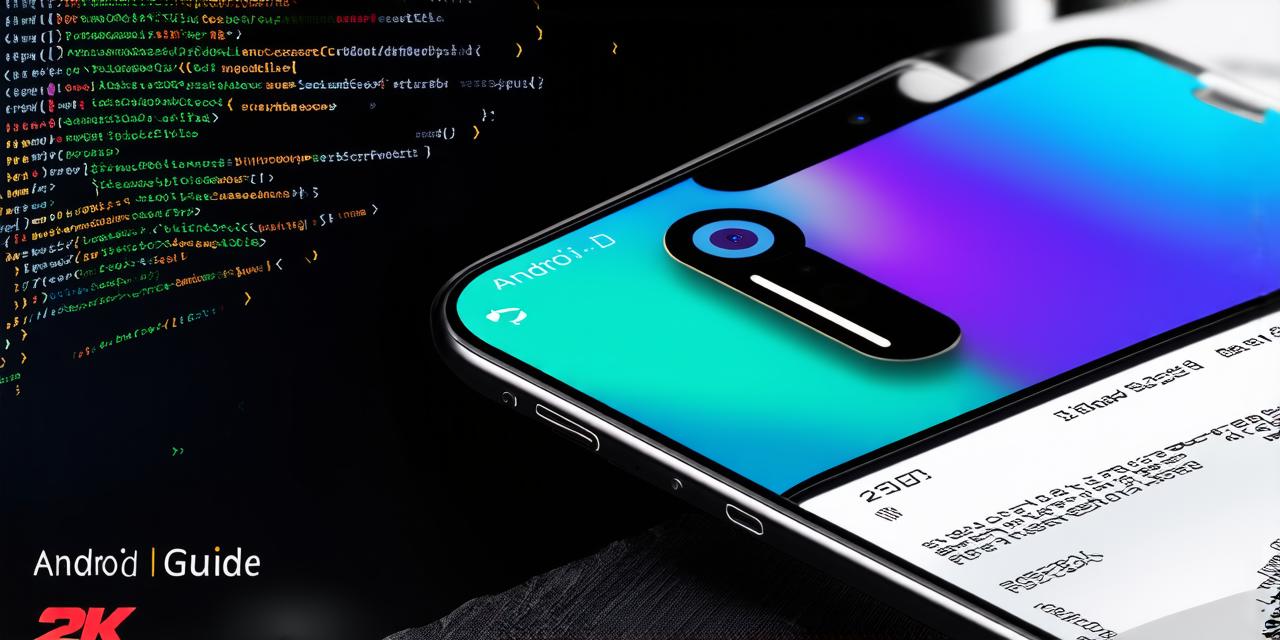Android development is a complex process that requires a deep understanding of programming languages and frameworks. With over 2.4 billion active devices running on the Android platform, it’s no wonder that developing Android apps has become one of the most in-demand skills in the tech industry.
Prerequisites for Android Development
Before diving into the world of Android development, there are a few prerequisites that you should be familiar with. These include:
- Programming Knowledge: While Android is built on Java, it’s important to have a solid understanding of programming concepts such as variables, loops, and functions. If you’re new to programming, we recommend taking an online course or tutorial to get up to speed.
- Basic Mathematics: While not as important as programming knowledge, basic mathematics skills are still necessary for understanding how algorithms work and how to optimize your code.
- Familiarity with IDEs: An Integrated Development Environment (IDE) is a software application that provides comprehensive facilities to computer programmers for software development. Android Studio is the official IDE for Android development, but there are many other IDEs available as well.
- Basic Knowledge of Operating Systems: Understanding how operating systems work is important when developing apps for mobile devices. While you don’t need to be an expert, having a basic understanding will help you understand how the Android platform works and how to optimize your app for different devices.
Setting Up Your Development Environment
Once you have the necessary prerequisites, it’s time to set up your development environment. Here are the steps to get started:
- Download and Install Android Studio: Android Studio is the official IDE for Android development. You can download it from the Google website or the Android Developers website. Once you have installed it, open it up and create a new project.
- Choose Your Development Environment: While Android Studio is the most popular IDE for Android development, there are many other IDEs available as well. Some of the most popular ones include Eclipse and IntelliJ IDEA. Choose the IDE that works best for you based on your preferences and experience level.
- Create a New Project: Once you have installed your IDE, create a new project by selecting “Start a new Android Studio project”. You will be prompted to enter the name of your app, select the minimum SDK version, and choose the activity template for your app.
- Set Up Your Device: To test your app on a real device, you’ll need to set up an Android device that runs on the same version of Android as your target SDK. You can either use a physical device or an emulator. We recommend using an emulator if you don’t have access to a physical device.
- Download the Android SDK: The Android Software Development Kit (SDK) contains all the tools and libraries you need to develop Android apps. You can download it from the Android Developers website. Once you have installed it, set up your environment variables so that your IDE can find the SDK.
- Choose Your App Template: Android Studio comes with several app templates that you can use as a starting point for your app. These include simple apps like note-taking and weather apps, as well as more complex ones like games and social media apps. Choose the template that best suits your needs.
Learning Java
Java is the programming language used to develop Android apps. While many developers are already familiar with Java, if you’re new to it, here are some resources to get you started:
- Oracle’s Java Tutorial: Oracle’s Java Tutorial is a comprehensive resource that covers all aspects of Java programming. It includes tutorials on variables, data types, control structures, and more.
- Codecademy’s Java Course: Codecademy’s Java Course is an interactive learning platform that teaches you Java through hands-on exercises and projects. It’s a great resource for beginners who prefer a more interactive approach to learning.
- Udacity’s Android Basics Nanodegree: Udacity’s Android Basics Nanodegree is a comprehensive course that covers all the basics of Android development, including Java programming. It includes hands-on projects and assessments to help you master the material.
- Google’s Developers Documentation: Google’s Developers Documentation is an extensive resource that provides detailed information on how to use the Android framework and APIs. It’s a great resource for advanced developers who want to learn more about the inner workings of the Android platform.
Learning Android Basics
Once you have a solid understanding of Java, it’s time to start learning about Android basics. Here are some resources to get you started:
- Google’s Developers Documentation: As mentioned earlier, Google’s Developers Documentation is an excellent resource for learning about the inner workings of the Android platform. It includes detailed information on how to create user interfaces, handle events, and work with the Android framework.
- Udacity’s Android Basics Nanodegree: Udacity’s Android Basics Nanodegree is a comprehensive course that covers all the basics of Android development, including creating user interfaces, handling events, and working with the Android framework. It includes hands-on projects and assessments to help you master the material.
- Android Architecture Components: The Android Architecture Components are a set of libraries that help you design and build scalable and maintainable Android apps. They include tools for data persistence, live data, and view modeling.
- Retrofit: Retrofit is a popular library for making HTTP requests from Android apps. It simplifies the process of making API calls and parsing JSON responses.
- RxJava: RxJava is a reactive programming library that makes it easy to write asynchronous code. It includes tools for handling events, managing subscriptions, and transforming data streams.
Creating Your First Android App
Now that you have a solid understanding of Java and the basics of Android development, it’s time to create your first app. Here are the steps:
- Choose Your App Idea: The first step in creating an Android app is to choose an idea for your app. This could be anything from a simple note-taking app to a more complex game or social media app.
- Create a Wireframe: Once you have an idea for your app, create a wireframe to visualize the user interface and how it will function. This will help you plan out the features of your app and ensure that everything flows smoothly.
- Write Your Code: With your wireframe in hand, start writing your code. Begin with the basic functionality of your app, such as creating a new note or logging in to a social media account. Gradually add more complex features as you go along.
- Test Your App: Once you have written your code, test your app on a real device or emulator to ensure that it works as expected. Make any necessary changes based on user feedback and testing results.
- Publish Your App: When your app is ready, publish it on the Google Play Store so that users can download and use it.
Summary
Developing Android apps can be a challenging but rewarding experience. With the right resources and a solid understanding of Java and Android basics, you can create apps that are both functional and engaging for users.



